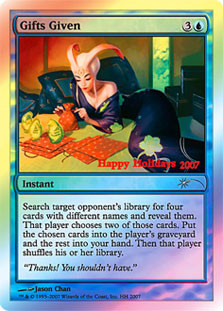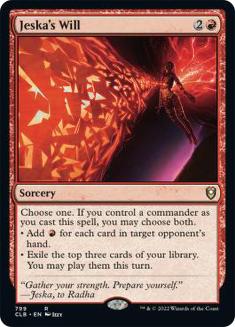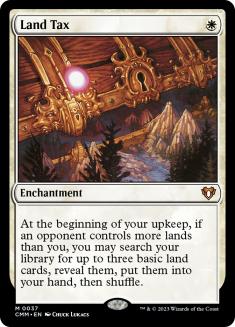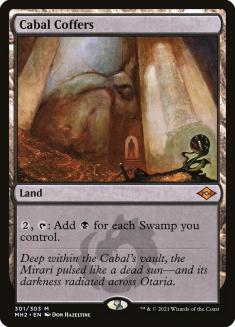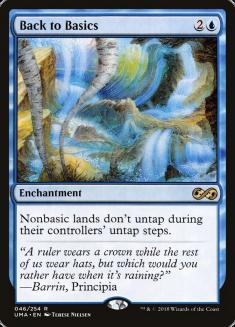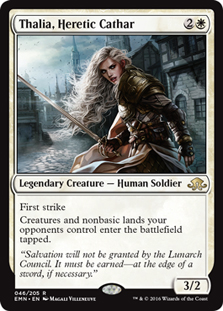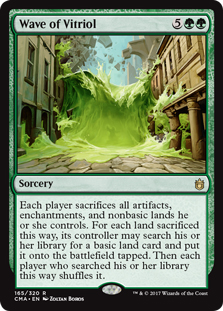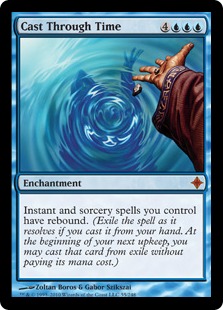Do you remember the crushing disappointment you felt as a child when you ripped open a rather enticing-looking Christmas present, only to find a pack of socks?
“But you need them,” your parents would say. And it’s true. You did need them, but you were expecting a Superplex Barbie Dream House or a big Tonka Truck… Not socks!
I feel the exact same way when it comes to lands. For years, I have been saying that lands are the socks of Magic. Many consider them the least exciting bits to buy when building a deck. But they don’t need to be. Whether it’s picking out your favorite blinged-out basics or fine-tuning your manabase to make sure you cast your favorite big, splashy spell… Like it or not, you need lands.
The Numbers Aren’t Adding Enough
Scalding Tarn of a hot take here: Commander players don’t run enough lands. Period. On average, I see decklists run 35-37 lands. However, the optimal number is 42.
The math behind this shocked me, as I am a stark defender of running 37 lands. However, the numbers add up here. We can apply traditional logic from 40- and 60-card formats to inform our argument here. It’s typically optimal to run seventeen lands in your 40-card Limited deck and 25 lands in your 60-card Constructed deck. We can extrapolate that land count for our commander deck and get that magic number of 42!
You want to guarantee that you hit your land drop every turn. Hitting your land drop every turn is the best, most consistent form of ramp your deck can run because each color has varying experiences when it comes to ramp.
In red, you have Jeska’s Will and Mana Geyser, but the amount of mana you get is inconsistent and entirely dependent on your opponents’ game state. White is less about ramping ahead and more about catching up thanks to Archaeomancer’s Map, Land Tax, and Knight of the White Orchid. Black has explosive potential with Bubbling Muck and the fragility of Nirkana Revenant, but landing a Cabal Coffers and Urborg, Tomb of Yawgmoth is where the color truly shines. Blue has High Tide and Energy Tap but leans heavily into artifact ramp.
With fleeting access to consistent land drops, none of these color-centric forms of ramp can even get off the ground to begin with.
The Importance Of Your Land Base
I often fall into the trap of running too much of a certain type of land. Sometimes I have a love affair with basics, and other times I find myself drawn to nonbasics. I used to never understand why having an excess of one or the other was considered a bad thing. Lands are lands, or at least that’s what I thought.
You need to put an emphasis on lands when you’re deckbuilding in order for your deck to flow smoothly. It took me years to understand this. It always confused me as to why people would run slow fetchlands like Evolving Wilds. Why not just run the basic land you were going to fetch for? It baffled me. However, as time has passed, I’ve grown to understand their necessity. It has felt like players have an aversion to basic lands.
High-key, players just aren’t running enough basic lands. It’s a controversial opinion. But it’s the truth. They’re not just for budget decks. Most commander decklists I see on Moxfield contain a plethora of costly, value-focused nonbasic lands with very few to no basics. Of course, there are definitely cheaper nonbasic options that fix your colors. They exist.
The fact that a basic land enters the battlefield untapped versus tapped is a huge factor these days as the format incrementally speeds up. Basics are the easiest way to make sure you can hit your land drop while also immediately casting that five-drop to set your gameplan in motion.
We are also seeing a rise in the running of spells that negatively impact nonbasic lands. Blood Moon turns them all to Mountains; Back to Basics freezes them; Thalia, Heretic Cathar makes them enter the battlefield tapped; and Wave of Vitriol flat-out replaces them with basics. (That is, if you’re running them in the first place!)
Sure, basic lands might not be glamorous, but the majority of ramp spells seek them out. From super-staples like Cultivate and Kodama’s Reach to underrated all-stars like Harvest Season and Traverse the Outlands, these amazing cards focus on getting you basics. (And not in the mean way, either.) There are definitely a few exceptions to the rule, but most cards urge you to run basics.
These days, lands also do more than just tap for mana. They can function as “free” spells and “free” removal with the introduction of modal double-faced cards (aka “modal DFCs” or “MDFCs”) and Neon Dynasty’s channel lands. The allure of this is incredibly attractive. Boseiju, Who Endures and Otawara, Soaring City provide interaction through Silence and Rule of Law effects, a huge deal at higher-powered tables. Valakut Stoneforge can draw you cards, and Bala Ged Recovery is basically an Eternal Witness disguised as a land. There’s so much free value to be had in your manabase.
Stop Cutting Lands
Finally, let’s address the age-old deckbuilding dilemma when it comes to lands. While brewing a new deck, I can often find that I’m more at ease cutting lands than cutting spells. Spells are flashy and exciting. I’d much prefer to keep my crazy creatures or Fiery Emancipation than a basic Forest or a Sunken Hollow. There have been moments on my deckbuilding stream where I cut two lands and then add an Ancient Tomb rather than cutting a spell. Sure, this can be beneficial in some decks, but it feels like a Band-Aid over a flesh wound. It might seem like a quick fix in the short term, but in the long run it isn’t optimal.
So how do we tackle what feels like second nature? Unlearning this can be rather hard. Everyone’s method is unique and personal. When I build a deck, I typically leave lands for last. However, starting with lands and creating a ballpark number can help give you a greater appreciation for your manabase. Before you add any cards to your decklist, add 42 basic lands as a placeholder.
I am, unfortunately, stubborn to a fault and set in my ways. Despite this suggestion, I still struggle with my manabase when deckbuilding. I always feel inclined to cut cards that don’t feel as fun. My chat noticed this struggle during my most recent stream and recommended a new way to solve the deckbuilding dilemma: start the deckbuilding process with 50 lands rather than 35-37. Overcompensating with your manabase can help when making cuts. Cutting that land you want to cut feels less bad when you’ve overcompensated. Of course, your manabase starting out might need some tweaking, depending on your curve and color distribution, but giving yourself a lot of slack can put things at ease when brewing.
It might sound like common sense, but you can’t play anything without lands. Hot take: the fewer lands you run, the less likely you’re able to cast that Cast Through Time you were so excited to include in your deck. You can’t “do the thing” if you can’t cast the thing. Cutting lands certainly seems like the way to do things, especially if you can just slot in an Ancient Tomb or a Lotus Field, but the risk isn’t worth it. Considering your lands as an active part of your deck is key to having a smooth play experience over time.
______________
I used to hate getting socks for Christmas, but over the years I’ve discovered that I am now excited by the prospect. The same goes for lands. I now hoard lands like some laundry-obsessed weirdo. Whenever I see an interesting nonbasic, I snatch it up and store it later for possible use. Lands at first glance might not seem glamorous like a Smothering Tithe or a Dockside Extortionist; however, without them, you can’t cast these exciting pieces. Without the foundation, your house falls apart. So next time you’re underneath the Christmas tree and you open socks, be sure to thank your parents. Happy holidays, deckbuilders.


